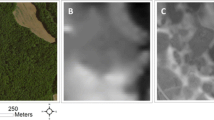Abstract
In preparing a major report on geographically isolated wetlands, the U.S. Fish and Wildlife Service (FWS) initiated a study of the extent of these wetlands across the country. The FWS used geographic information system (GIS) technology to analyze existing digital data (e.g., National Wetlands Inventory data and U.S. Geological Survey hydrologic data) to predict the extent of isolated wetlands in 72 study areas. Study sites included areas where specific types of “isolated” wetlands (e.g., Prairie Pothole marshes, playas, Rainwater Basin marshes and meadows, terminal basins, sinkhole wetlands, Carolina bays, and West Coast vernal pools) were known to occur, as well as areas from other physiographic regions. In total, these sites represented a broad cross-section of America’s landscape. Although intended to show examples of the extent of isolated wetlands across the country, the study was not designed to generate statistically significant estimates of isolated wetlands for the nation. As expected, the extent of isolated wetlands was quite variable. The study found that isolated wetlands constituted a significant proportion of the wetland resource in arid and semi-arid to subhumid regions and in karst topography. Eight study areas had more than half of their wetland area designated as isolated, while 24 other areas had 20–50 percent of their wetland area in this category. For most sites, isolated wetlands represented a greater percent of the total number of wetlands than the percent of wetland area. This was largely attributed to difference in wetland size, with most non-isolated wetlands being larger than the isolated wetlands. Forty-three sites had more than 50 percent of their total number of wetlands designated as isolated. The estimates of isolated wetlands presented in this study cannot be readily translated to wetlands that have lost Clean Water Act “protection” based on a recent U.S. Supreme Court ruling for several reasons, including the lack of written guidance on interpreting the Court’s decision for identifying jurisdictional wetlands. The results of this GIS analysis present one perspective on the extent of geographically isolated wetlands in the country and represent a starting point for more detailed assessments.
Similar content being viewed by others
Literature Cited
Association of State Wetland Managers. 2001. Consistent methods for identifying waters that may no longer be regulated under the Clean Water Act following the SWANCC decision. Berne, NY, USA. (www.aswm.org/swancc)
Bailey, R. G. 1995. Ecoregions of the United States. Description of the ecoregions of the United States. U.S. Forest Service, Washington, DC, USA. Misc. Publication No. 1391.
Environmental Laboratory. 1987. Corps of Engineers Wetlands Delineation Manual. U.S. Army Engineer Waterways Experiment Station, Vicksburg, MS, USA. Tech. Rep. Y-87-1. (online version at: http://www.wes.army.mil/el/wetlands/pdfs/wlman87.pdf)
Illinois Department of Natural Resources. 2001. Wetland testimony to Representative May September 20, 2001. Illinois Department of Natural Resources, Springfield, IL, USA.
LaGrange, T. 2001. Estimated acres of isolated wetlands in Nebraska. Nebraska Game and Parks Commission, Lincoln, NE, USA.
National Research Council. 1995. Wetlands: Characteristics and Boundaries. National Academy Press, Washington, DC, USA.
Petrie, M., J.-P. Rochon, G. Tori, R. Pederson, and T. Moorman. 2001. The SWANCC decision: implications for wetlands and waterfowl. Ducks Unlimited, Inc., Memphis, TN, USA.
Tiner, R. W. 1990. Use of high-altitude aerial photography for inventorying forested wetlands in the United States. Forest Ecology and Management 33/34:593–604.
Tiner, R. W. 1999. Wetland Indicators: A Guide to Wetland Identification, Delineation, Classification, and Mapping, Lewis Publishers, CRC Press, Boca Raton, FL, USA.
Tiner, R. W. 2003. Geographically isolated wetlands of the United States. Wetlands 23:494–516.
Tiner, R. W., H. C. Bergquist, G. P. DeAlessio, and M. J. Starr. 2002a. Geographically isolated wetlands: a preliminary assessment of their characteristics and status in selected areas of the United States. U.S. Department of the Interior, Fish and Wildlife Service, Northeast Region, Hadley, MA, USA. (web-based report at: http://wetlands.fws.gov/Pubs_Reports/isolated/geoisolated.htm)
Tiner, R. W., H. C. Bergquist, and B. J. McClain. 2002b. Wetland characterization and preliminary assessment of wetland functions for the Neversink Reservoir and Cannonsville Reservoir Basins of the New York City water supply watershed. U.S. Fish and Wildlife Service, Northeast Region, National Wetlands Inventory Program, Hadley, MA, USA.
Tiner, R. W., H. C. Bergquist, J. Q. Swords, and B. J. McClain. 2001. Watershed-based wetland characterization for Delaware’s Nanticoke River watershed: a preliminary assessment report. U.S. Fish and Wildlife Service, Northeast Region, National Wetlands Inventory Program, Hadley, MA, USA.
Tiner, R., M. Starr, H. Bergquist, and J. Swords. 2000. Watershed-based wetland characterization for Maryland’s Nanticoke River and Coastal Bays watersheds: a preliminary assessment report. U.S. Fish and Wildlife Servic, Northeast Region, National Wetlands Inventory Program, Hadley, MA, USA.
Tiner, R., S. Schaller, D. Petersen, K. Snider, K. Ruhlman, and J. Swords. 1999. Wetland characterization study and preliminary assessment of wetland functions for the Casco Bay watershed, southern Maine. U.S. Fish and Wildlife Service, Northeast Region, National Wetlands Inventory Program. Hadley, MA, USA.
U.S. Geological Survey. 1970. The National Atlas of the United States of America. U.S. Department of the Interior. Washington, DC, USA.
Wisconsin Department of Natural Resources. 2001. Unprotected wetlands. Wetland acreage affected by the SWANCC Supreme Court decision. Wisconsin Department of Natural Resources, Madison, WI, USA.
Author information
Authors and Affiliations
Corresponding author
Rights and permissions
About this article
Cite this article
Tiner, R.W. Estimated extent of geographically isolated wetlands in selected areas of the United States. Wetlands 23, 636–652 (2003). https://doi.org/10.1672/0277-5212(2003)023[0636:EEOGIW]2.0.CO;2
Received:
Revised:
Accepted:
Issue Date:
DOI: https://doi.org/10.1672/0277-5212(2003)023[0636:EEOGIW]2.0.CO;2




